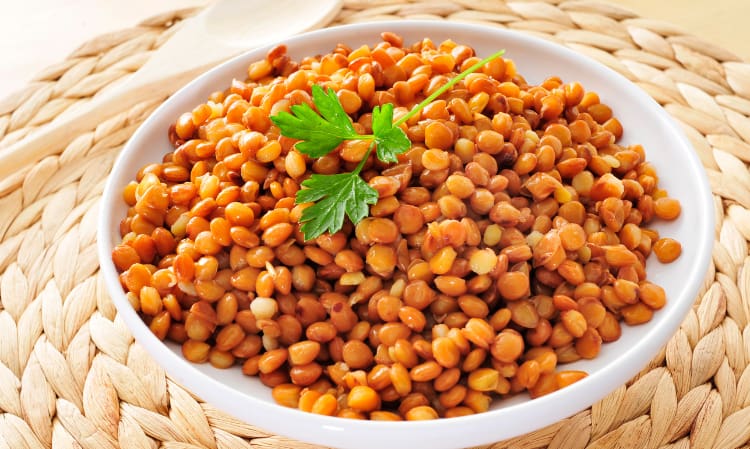Extremely cheap but extremely rich in plant-based protein and iron: this is why, already in the past, lentils were considered the “poor man’s meat“. Now that we know how important it is to privilege the consumption of plant-based protein sources over animal ones, the health benefits of lentils are even more appreciated. 🌱
Let’s have a look at the top 5 health benefits of lentils, and learn some quick tips on how to decrease the chances of getting bloated when consuming them.
The Main Health Benefits of Lentils: the power of pulses!
Red, brown/green, or beluga lentils? Lentils are one of the world’s oldest and most cultivated legumes, which makes them a true staple in many households. Plus, they are extremely versatile and inexpensive, and, because of their small size, they don’t need to be soaked before cooking. But did you know that lentils are also full of amazing – and often unknown – health benefits? Let’s discover the main ones.
1. A great source of plant-based protein and iron
With as much as a third of their calories coming from proteins (around 18 grams for a cup of cooked lentils) and almost 37% of the daily recommended intake of iron for one medium portion (around 198 grams), lentils can be considered a great plant-based meat substitute – at least, as far as the nutritional value is concerned. Indeed, it’s not a case that, especially in the past, lentils were considered the “poor man’s meat”.
But there is even more to this! Indeed, unlike meat, lentils do not contain any saturated fats or LDL cholesterol, whilst being rich in dietary fibers and lots of different vitamins and minerals. The only thing to be aware of is the fact that, like other types of pulses, lentils are low in a couple of essential amino acids, namely methionine and cysteine. Luckily, this is easily addressed by combining lentils with cereal grains such as rice, barley, millet, quinoa, and so on (you don’t even have to eat them in the same meal, just throughout the same day)!
2. The antioxidant properties of lentils
Did you know that lentils are rich in antioxidants? The main ones are plant compounds known as phenols. The phenolic content of lentils is not only great to prevent cell oxidation, but has also an excellent antioxidant, antibacterial, antiviral, and anti-inflammatory effects.
Second on the list are polyphenols such as procyanidin and flavonols which, again, are known to have strong antioxidant, anti-inflammatory, and neuroprotective effects.
Last but not least, lentils contain vitamin C, which is essential in collagen production. Collagen can, in turn, promote skin tone and elasticity and strengthen nails and hair. This is why the regular consumption of lentils can almost be equated to a beauty treatment! 🤣
3. Promote good digestion and weight loss
Among the health benefits of lentils is also the promotion of better digestive health. Indeed, lentils are rich in dietary fiber (around 8 grams for half a cup of cooked product), which can help promote regular bowel movements and a flatter tummy. In addition, lentils are also a good source of prebiotics. These act like “fertilizers” that stimulate the growth of healthy bacteria in the gut, which are essential for speeding up our digestion.
The high fiber content is also responsible for allowing us to feel fuller and much more satiated after a meal. This is why eating fiber-rich foods can help us with weight loss and management.
4. Help to manage blood sugar levels
Can diabetics eat lentils? The answer is yes! Indeed, these pulses are very rich in fiber and therefore have a quite low glycemic index (GI), around 21-22 depending on the specific type of lentil. This means that the nutrients contained in lentils are absorbed relatively slowly into the bloodstream, thus benefitting the management of blood sugar levels.
Moreover, studies have shown that beans and other legumes can help reduce inflammation in people with diabetes.
5. Support heart health
Lastly, lentils are great for supporting heart health. Indeed, besides being free of cholesterol and saturated fats, lentils are rich in fiber, potassium, and folate, all nutrients that can help lower blood pressure levels.
In addition, lentils are an excellent source of iron and vitamin B1. Both can promote the formation of red blood cells and therefore help maintain a steady heartbeat.
Are there any risks with the consumption of lentils?
When inserted into a well-balanced and varied diet, lentils can be consumed multiple times a week. However, we have to be mindful of the fact that, like any other legume, lentils contain natural compounds commonly referred to as ‘anti-nutrients’.
Among them are lectins, which can resist digestion and bind to other nutrients, preventing their absorption. Other anti-nutrient that can be found in lentils are phytic acid and tannins which, similarly to lectins, binds with iron and zinc, making the minerals harder for us to absorb.
In any case, the amounts of these three anti-nutrients in lentils are very contained. Plus, it can be further reduced by soaking and cooking the lentils.
Another “risk” associated with the consumption of lentils is the production of excessive gas and bloating. This is generally caused by a specific type of carbohydrate that is hard for our body to digest. This can be particularly severe in subjects suffering from irritable bowel syndrome (IBS) or other digestive conditions. However, there are some tips that can help reduce the bloat from lentils. Let’s have a look at them.
Tips on how to prevent gas and bloating when eating lentils
Reducing the bloat caused by lentils is possible. Here is how:
- Rinse before cooking: if you have opted for canned lentils, rinsing them (preferably under cold water) helps eliminate the indigestible carbohydrates that are commonly found in their preserving liquid. As an added bonus, it also helps remove any excess sodium.
- Soak them overnight: if you’re using dried lentils, soak them for at least 4 hours (or, even better, overnight). You can even add a couple of bay leaves or a sheet of kombu seaweed to make them softer and more digestible. Then make sure to give your lentils a good rinse before cooking to wash away the gas-producing carbohydrates.
- Introduce them slowly: this tip is for all of those that are new to eating lentils! Indeed, lentils can cause a lot of gas if you are not used to consuming them, as they are particularly rich in fiber. To give our gut bacteria the right time to adjust to the increased fiber intake, it might be useful to introduce them in small quantities (as little as 20 grams), which will be then increased over time. By doing that, you will be able to eat a normal portion of lentils with little to no flatulence.
- Use decorticated lentils or lentil pasta: decorticated lentils are easier to digest, as they have been stripped of their external skin, which is the part richer in oligosaccharides (the “indigestible” carbohydrates). Alternatively, you can use lentil pasta, which is made with just water and the flour obtained from lentils.
Nutrition Facts about Lentils
Lentils are a legume high in fiber, plant protein, and lots of different minerals and vitamins. Among them, they are particularly rich in iron, folate, and manganese. In addition, they are very poor in calories, which makes them ideal for weight loss and maintenance diets.
Though the nutritional profile might slightly vary between different types of lentils, 1 cup (198 grams) of cooked lentils generally contains:
- Calories: 230
- Carbs: 39.9 grams
- Protein: 17.9 grams
- Fat: 0.8 grams
- Fiber: 15.6 grams
- Thiamine: 28% of the DV
- Niacin: 13% of the DV
- Vitamin B6: 21% of the DV
- Folate: 90% of the DV
- Pantothenic acid: 25% of the DV
- Iron: 37% of the DV
- Magnesium: 17% of the DV
- Phosphorus: 28% of the DV
- Potassium: 16% of the DV
- Zinc: 23% of the DV
- Copper: 55% of the DV
- Manganese: 43% of the DV
Fun Facts about Lentils
- The word lentil comes from the Latin word lens. Indeed, this legume is shaped like the double convex optic lens that took its name from the lentil.
- They are the oldest pulse crop known to man and one of the earliest domesticated crops.
- Lentils are mentioned several times in the Bible; one example is in the book of Genesis and the story of Esau, who gave up his birthright for a bowl of crimson lentils and a loaf of bread.
- Italians eat lentils on New Year’s Eve to attract more wealth and abundance into the upcoming year.
Ingredient Selection Tips for Lentils
There are three main types of lentils on the market: yellow or red, brown or green, and beluga lentils. Each of them is best used in different preparations. For example, softer lentils, like red lentils, work best for soups, dhals, and purées. On the other hand, firmer lentils, like French green lentils, are ideal for salads, fritters, and veggie burgers.
When buying dried pulses, make sure that the lentils are dry and firm, and that they have a uniform color. If in a sealed package or airtight container, they can be stored for over a year in a cool, dry, dark place. Alternatively, after they have been cooked, they can be stored in the freezer for up to three months, or in the fridge for up to one week.
The Cultivation of Lentils
Lentils are one of the easiest crops to cultivate, as they can perform well in almost all types of seedbeds. They are usually sown in late April or early May, as the soil temperatures must be above 40 ° F (or 4 ° C). By seeding early, farmers are able to increase the height and size of the plant at the first bloom.

All varieties are then harvested between August and September. Lentils are cut and swathed into windrows one week before harvesting. In this way, the weeds have time to dry down before the legume is extracted from the pod. The lentils are then stored in a dry and dark place for a couple of weeks before they are ready for being consumed.
My Favorite Recipes with Lentils, earthy and high in protein
Lentils are a true staple in my kitchen! They are a good alternative to meat, they are very versatile and can be used in many different dishes, and they are simply delicious!
Among my favorite recipes are this Lentil Sloppy Joe in the Instant Pot and this Spicy Red Lentil Curry (Dahl). I also love to use them in soups, such as these Butternut Squash Lentil Soup, Curried Pumpkin Lentil Soup, and Indian Chickpea Lentil Soup.

In addition, lentils can be used to prepare some delicious meatless burgers and meatloaves, such as these Meatless Meatloaf and Lentil Beet Burger.

If you like this type of informative post, please let me know in the comments! And let’s connects also on my socials (the links are down below) 💗













Pingback: Butternut Squash Lentil Soup (Instant pot recipe)